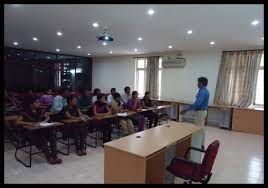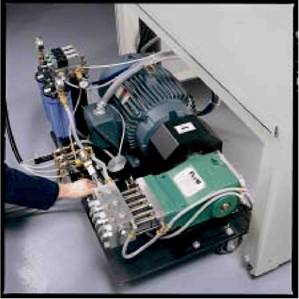





Published on Apr 02, 2024
Waterjet cutting, introduced in the early '70s, uses a highly pressurized stream of water, sometimes with an added abrasive. The waterjet stream, moving at nearly three times the speed of sound, can penetrate almost any material and thickness. Waterjets are often used on composites and plastics that cannot tolerate heat, mechanical damage, or delamination. And because the jet of water is constricted to a tiny diameter at such high pressures, the workpiece does not get wet.
Manufacturers wanting to cut plastics, glass, metals, and food more efficiently, are often thwarted by the slow and inexact cutting caused by knives, shears, saws, and other technologies. Graphite/epoxy composites cannot be cut to the required tolerances even with plasma arc or laser cutting. However, waterjets can cut to near-net shape on complex configurations and produce high-quality, dust-free cuts in virtually any material.
Waterjets are widely used in aero-space, automotive, electronics, and other industries to cut products like titanium aircraft components, printed circuit boards, automobile dashboards, diapers, cake and candy.
Automated waterjet cutting systems offer power, accuracy, and repeatability. Rapid growth of this technology is expected.
Anadvantage of waterjet cutting is improved product quality. Waterjets don't generate heat in the material being cut, so the product has no heat affected zone, dross, or heat warpage, thus eliminating thermal and mechanical distortion. It cuts with a very narrow kerf, leaving a clean, finished edge.
Waterjets can cut a wide range of materials including metals, plastics, composites (fiberglass, graphite/epoxy), engineering materials, paper, glass, and food. Thicknesses and densities can vary without requiring complicated adjustments.
Adaptable to automation, nearly all waterjet systems utilize some type of automated carrier device. From x-y motion tables to CAD/CAM and 5-axis robotic systems, automated waterjets are accurate and can cut complex shapes and configurations.
Waterjet cutting is omnidirectional, enabling accurate cuts to be made at any angle, even a tight inside radius. A waterjet can easily cut starter holes in the center of a workpiece, a difficult task with other methods.
Since waterjets produce a clean edge cut, even on dense or hard materials, finishing steps are often eliminated. The waterjet does not burn the cut edge so cleaning is not required.
And finally, the waterjet carries away the eroded material, practically eliminating dust, pollutants, and fumes associated with other cutting methods.
The basic technology is both simple and extremely complex. At its most basic, water flows from a pump, through plumbing and out a cutting head. It is simple to explain, operate and maintain. The process, however, incorporates extremely complex materials technology and design. To generate and control water at pressures of 60,000 psi requires science and technology not taught in universities. At these pressures a slight leak can cause permanent erosion damage to components if not properly designed. Thankfully, the Waterjet manufacturers take care of the complex materials technology and cutting-edge engineering. The user need only be knowledgeable in the basic waterjet operation.
Essentially, there are two types of waterjets; (1) pure Waterjet and (2) abrasive Waterjet. Machines are designed to employ only Waterjet, only abrasive Waterjet, or both. With any type, the water must first be pressurized.
The pump is the heart of the waterjet system. The pump pressurizes the water and delivers it continuously so that a cutting head can then turn that pressurized water into a supersonic waterjet stream. Two types of pump can be used for waterjet applications — an intensifier based pump and a direct drive based pump.
The direct drive pump operates in the same manner as a low-pressure "pressure washer" that you may have used to pressure wash a house or deck prior to repainting. It is a triplex pump that gets the movement of the three plungers directly from the electric motor. These pumps are gaining acceptance in the Waterjet industry due to their simplicity. At the time of this writing, direct drive pumps can deliver a maximum continuous operating pressure 10 to 25% lower than intensifier pumps units (20k to 50k for direct drive, 40k to 60k for intensifiers).

Direct Drive pump is a relatively new type of high-pressure pump (commercially available since late 1980's).
Though direct drive pumps are used in some industrial applications, the vast majority of all ultra-high pressure pumps in the waterjet world today are intensifier based.
Two fluid circuits exist in a typical intensifier pump, the water circuit and the hydraulic circuit. The water ckcuit consists of the inlet water filters, booster pump, intensifier, and shock attenuator. Ordinary tap water is filtered by the inlet water filtration system — usually comprising of a 1 and a 0.45 micron cartridge filter. The filtered water then travels to the booster pump, where the inlet water pressure is maintained at approximately 90 psi -ensuring the intensifier is never "starved for water." The filtered water is then sent to the intensifier pump and pressurized to up to 60,000 psi.
Before the water leaves the pump unit to travel through the plumbing to the cutting head, it first passes through the shock attenuator. This large vessel dampens the pressure fluctuations to ensure the water exiting the cutting head is steady and consistent. Without the attenuator, the water stream would visibly and audibly pulse, leaving marks on the material being cut.
| Are you interested in this topic.Then mail to us immediately to get the full report.
email :- contactv2@gmail.com |